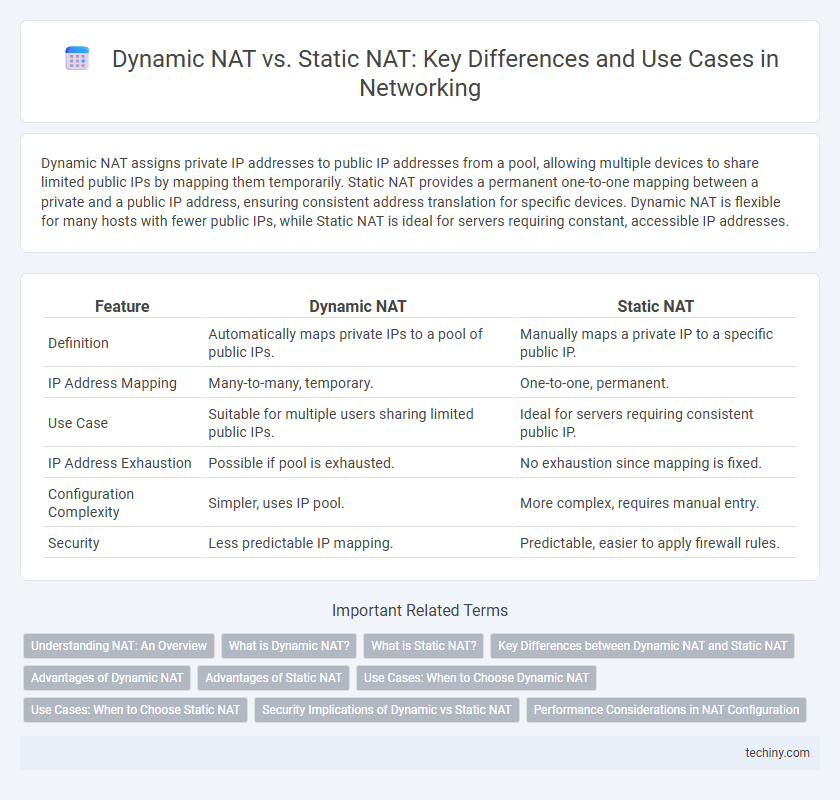Dynamic NAT assigns private IP addresses to public IP addresses from a pool, allowing multiple devices to share limited public IPs by mapping them temporarily. Static NAT provides a permanent one-to-one mapping between a private and a public IP address, ensuring consistent address translation for specific devices. Dynamic NAT is flexible for many hosts with fewer public IPs, while Static NAT is ideal for servers requiring constant, accessible IP addresses.
Table of Comparison
| Feature | Dynamic NAT | Static NAT |
|---|---|---|
| Definition | Automatically maps private IPs to a pool of public IPs. | Manually maps a private IP to a specific public IP. |
| IP Address Mapping | Many-to-many, temporary. | One-to-one, permanent. |
| Use Case | Suitable for multiple users sharing limited public IPs. | Ideal for servers requiring consistent public IP. |
| IP Address Exhaustion | Possible if pool is exhausted. | No exhaustion since mapping is fixed. |
| Configuration Complexity | Simpler, uses IP pool. | More complex, requires manual entry. |
| Security | Less predictable IP mapping. | Predictable, easier to apply firewall rules. |
Understanding NAT: An Overview
Dynamic NAT maps private IP addresses to public IP addresses from a pool, allowing multiple devices to share a limited number of public IPs while maintaining address conservation. Static NAT provides a one-to-one mapping between a private IP and a fixed public IP, ensuring consistent address translation for services requiring permanent accessibility. Understanding these NAT types is crucial for designing efficient network address translation strategies that balance flexibility and accessibility.
What is Dynamic NAT?
Dynamic NAT (Network Address Translation) automatically maps private IP addresses to available public IP addresses from a predefined pool, allowing multiple devices to share a limited number of public IPs. Unlike Static NAT, which creates a fixed one-to-one mapping, Dynamic NAT provides temporary address translation that changes with each session. This method enhances address utilization efficiency and is commonly used in enterprises with numerous internal hosts accessing external networks.
What is Static NAT?
Static NAT (Network Address Translation) maps a specific private IP address to a fixed public IP address, ensuring consistent communication for devices requiring permanent external access. It is commonly used for hosting servers and applications that must be reachable from outside the private network. Unlike Dynamic NAT, Static NAT provides a one-to-one, unchanging IP address translation that simplifies inbound traffic management and firewall configuration.
Key Differences between Dynamic NAT and Static NAT
Dynamic NAT automatically maps private IP addresses to a pool of public IP addresses on a first-come, first-served basis, optimizing limited IP resources but creating changing mappings. Static NAT assigns a fixed one-to-one relationship between a private IP and a public IP, ensuring consistent address mapping critical for hosting servers or services. Dynamic NAT offers scalability with dynamic address allocation, whereas Static NAT guarantees permanent and predictable IP address translation.
Advantages of Dynamic NAT
Dynamic NAT efficiently conserves public IP addresses by mapping multiple private IP addresses to a limited pool of public IPs, reducing the need for a one-to-one address allocation. It enhances network security by dynamically assigning external mappings only when needed, minimizing potential exposure of internal devices. This flexibility simplifies administration in growing networks, adapting to changing demands without requiring manual reconfiguration.
Advantages of Static NAT
Static NAT provides consistent IP address mapping, ensuring reliable remote access to internal servers and devices by maintaining the same public IP address. It enhances security by allowing precise control over address translation, preventing unauthorized access through predictable, fixed mappings. Static NAT also simplifies troubleshooting and monitoring by offering a stable, one-to-one address relationship between private and public IPs.
Use Cases: When to Choose Dynamic NAT
Dynamic NAT is ideal in scenarios where internal devices need temporary access to external networks without requiring permanent public IP addresses, such as in enterprise environments with numerous hosts accessing the internet unpredictably. It conserves public IP addresses by dynamically assigning mappings only when needed, making it a cost-effective solution for organizations with limited IPv4 resources. Dynamic NAT is best suited for users who do not require inbound connections from the internet, focusing on outbound communication efficiency and scalability.
Use Cases: When to Choose Static NAT
Static NAT is ideal for hosting servers that require consistent IP address mapping, such as web servers, email servers, and VPN gateways, ensuring reliable external access. It is preferred when devices need permanent IP addresses for remote access or when IP address predictability is crucial for security policies. Static NAT supports applications that cannot tolerate changes in IP addresses, maintaining seamless communication and connectivity.
Security Implications of Dynamic vs Static NAT
Static NAT maintains a constant one-to-one mapping between private and public IP addresses, allowing precise control over traffic and making it easier to implement strict firewall rules for enhanced security. Dynamic NAT assigns public IP addresses from a pool on a temporary basis, which can obscure internal network structures but complicates consistent access control and monitoring. Static NAT's predictability facilitates better tracking and security auditing, whereas Dynamic NAT's ephemeral mappings may introduce vulnerabilities if not properly managed.
Performance Considerations in NAT Configuration
Dynamic NAT offers improved address utilization by mapping multiple private IP addresses to a pool of public IPs, reducing the risk of IP exhaustion and enhancing scalability. Static NAT provides consistent address mapping, which simplifies troubleshooting and maintains stable connections, but can lead to inefficient IP usage and higher management overhead. Performance in NAT configurations depends on traffic volume and network size; dynamic NAT excels in large, variable environments, while static NAT performs better in scenarios requiring predictable, fixed IP assignments.
Dynamic NAT vs Static NAT Infographic

 techiny.com
techiny.com